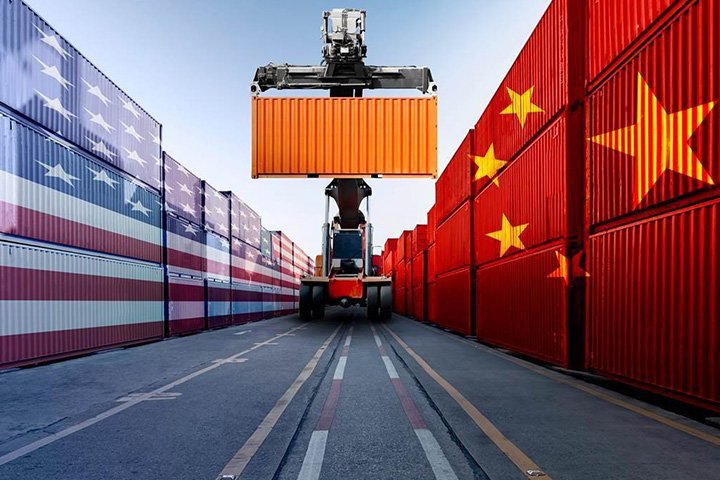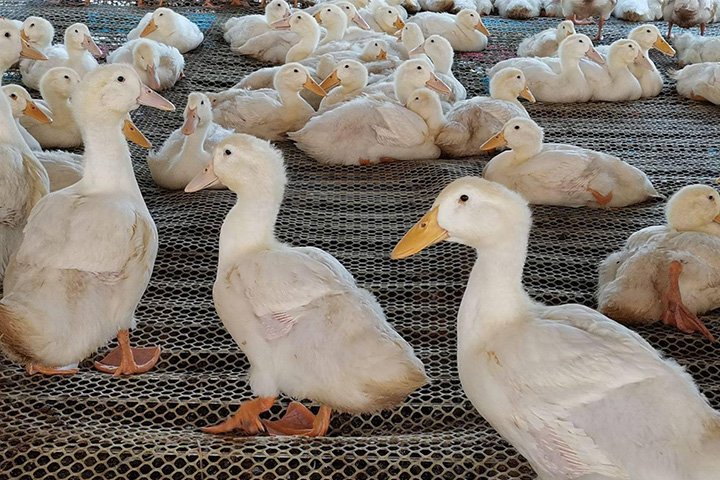Cn-down > Domestic news > News content
2024-06-03 来源:金绒 浏览量:1559
Summary
In the 22nd week of 2024 (5.27-6.2), the market price generally rose, among which duck down had a larger increase.

In mid-May, the temperature in many places in the north rose. Zhengzhou, Henan, Xi'an, Shaanxi, Taiyuan, Shanxi, Jinan, Shandong and other places saw the first high temperature day of the year, about ten days earlier than in previous years. As the weather suddenly became hot, the breeding of meat ducks began to become difficult. High mortality rates were heard in some areas, which also caused the price of white duck down to rise again. There are trends indicating that this summer may be hotter than in previous years.
As the price of raw down rises again, companies selling raw down and down products are reluctant to sell. However, it is worth noting that product companies may not recognize the price increase of finished down driven by the current rise in raw material prices, which will lead to stagnation of finished down prices. In the future, all links in the industrial chain will need to further compete in the market.
Good news this week
On May 24, Eastern Time, the Office of the United States Trade Representative announced that it would extend the "301 tariff exemption period for 352 Chinese imported goods and 77 epidemic-related categories of Chinese imported goods" from the original expiration date of May 31 to June 14, but a small number of exemption items will be extended to May 31, 2025.
Many products will face additional tariffs again, including 102 categories. The office said these are items for which there have been no public requests for further deferrals or evidence that extending the exemptions would help shift purchases away from China.
These product categories include garage door openers, switches for motor vehicles, printed circuit board assemblies, electric motorcycles, natural graphite and a range of duffel and messenger bags.

The Office of the United States Trade Representative said it would extend the exemptions to June 14 to facilitate a transition; certain exclusions would be extended to May 31, 2025 to support efforts to shift purchases out of China or provide additional time if supply of products outside of China remains limited.
In Annex C of the announcement, the exemption period for 164 products will be extended to May 31, 2025, including three products: "feather filling", "down filling" and "cotton pillows filled with duck down or goose down".
| 税号及产品描述 |
美国税号: Feathers(Meeting both test standards 4 and 10.1 of Federal Standard 148a promulgated by the General Services Administration) 羽毛(符合总务管理局颁布的联邦标准148a第4和10.1条的试验标准) |
美国税号: Down(Meeting both test standards 4 and 10.1 of Federal Standard 148a promulgated by the General Services Administration) 羽绒(符合总务管理局颁布的联邦标准148a第4和10.1条的试验标准) |
| 美国税号: Pillow shells of cotton, each filled with goose or duck down 填充鸭绒或鹅绒的棉质枕头 |
source | 金绒采编自美国贸易代表办公室
At the beginning of the second quarter, China's economy continued to recover steadily, with industrial production rebounding strongly. Data released by the National Bureau of Statistics showed that the added value of industrial enterprises above designated size in April increased by 6.7% year-on-year. From a month-on-month perspective, in April, the added value of industrial enterprises above designated size increased by 0.97% from the previous month.
In terms of industries, in April, the added value of 36 out of 41 major industries maintained year-on-year growth. Among them, the leather, fur, feather and its products and footwear industries grew by 6.7% in April, and the added value increased by 3.9% in total from January to April.

The National Bureau of Statistics pointed out that, overall, the national economy operated smoothly in April, with major indicators such as industry, exports, employment, and prices improving overall. New momentum maintained rapid growth, the national economy continued to recover and improve, and positive factors accumulated and increased.
From January to April 2024, the total profits of industrial enterprises above designated size nationwide reached 2,094.69 billion yuan, a year-on-year increase of 4.3%. In April alone, the profits of industrial enterprises above designated size increased by 4.0% year-on-year, turning positive compared with -3.5% in the same period last year.

The “leather, fur, feather and its products and footwear industry” achieved a total operating income of 253.14 billion yuan from January to April, a year-on-year increase of 6.0%; operating costs of 218.70 billion yuan, a year-on-year increase of 5.7%; total profit of 10.81 billion yuan, a year-on-year increase of 18.7%. The industry's profits have improved significantly compared with last year.
Researchers said that from the industry perspective, profits in industries ranging from textiles and furniture to chemical fibers and chemical raw materials have shown signs of improvement, reflecting that the recovery in domestic terminal market demand is gradually being transmitted to the middle and upper reaches, but there is still obvious differentiation in the operating conditions of the industry, and industries such as oil and coal are still affected by fluctuations in international commodity prices.
source | 金绒整理自国家统计局、中国经营报
The number of orders provided strong evidence for the growth of foreign trade exports. Since the beginning of this year, the number of foreign trade orders for textile fabrics has increased significantly, and large orders of millions of meters have become the norm again. Moreover, orders continue to come in, and the number of orders has shown a significant recovery trend.
"Our company's performance has achieved significant growth, with a growth rate of up to 20%, mainly due to the strong performance of export business in Europe and the United States. Overall, global market demand is gradually recovering, and our customers are also successfully selling products in various regions overseas." said Mr. Chen, who specializes in outdoor sports fabrics.
Many companies said that their orders in May were relatively stable, mainly focusing on the production of autumn and winter fabrics in the second half of the year. Mr. Gao, who works in foreign trade, said that the overall order reception in May was similar to that in April, and they are currently focusing on the production of autumn and winter fabrics in the second half of the year, among which varieties such as pongee and four-way stretch account for a large proportion.

Mr. Shen from a spot company said that they are busy processing the autumn and winter orders that have been placed one after another. Mr. Chen, a foreign trade company specializing in outdoor sports fabrics, said that they are currently focusing on producing autumn and winter fabrics for the second half of the year, among which high-quality fabrics such as T400 and T800 account for a large proportion.
At present, the supply of 300T polyester pongee grey fabric in the market has become tight, and many traders and clothing companies are actively looking for sources to ensure production progress and product quality.
This is closely related to market demand and supply. On the one hand, the production of autumn and winter clothing fabrics has begun, and 300T polyester spring is the focus, and the demand has risen accordingly; on the other hand, due to the increase in orders, the 300T polyester spring on the market has been swept away, resulting in a shortage of supply.
source | 布工厂
At about 15:00 on May 29, a train loaded with 8 standard boxes of down pillows slowly drove out of the Zhuji East Station freight yard and headed for Ningbo Zhoushan Port. This was the successful first launch of the Zhuji-Dubai Haigang Cloud Warehouse "door-to-door" full-process logistics sea-rail intermodal transport, and also the first linkage between Ningbo Zhoushan Port's sea-rail intermodal transport business and Haigang Cloud Warehouse.
In June 2022, Zhejiang Haigang Group invested in and built Haigang Cloud Warehouse Dubai Station in Dubai, which became the group's first overseas project. Cloud Warehouse is located in the largest free trade zone in the Middle East, Jebel Ali Free Trade Zone, adjacent to the largest international transit port in the Middle East, Jebel Ali Port.

"With this hub, Ningbo-Zhoushan Port can combine its port advantages with the locational advantages of overseas free trade zones, vigorously develop international transit consolidation, end-to-end logistics, etc., and further enhance the ability of overseas outlets to attract business." said a relevant person in charge of Dubai Port Cloud Warehouse.
This year, in order to enhance the influence of Ningbo-Zhoushan Port's international logistics services in the Middle East, North Africa and other regions, Ningbo-Zhoushan Port has taken the seaport cloud warehouse as a starting point to actively expand cross-border logistics, full-process logistics and multimodal transport, while accelerating the construction of an integrated service platform for shipping agency, freight forwarding, customs clearance, warehousing, and distribution, helping more companies to enjoy the overseas service of "one warehouse in hand to sell to the world".
source | 潮新闻
Bad news this week
The current duckling price is in a dilemma of rising and falling, and the game between upstream and downstream is intensifying. From the supply of ducklings, in the current 21st week, the average daily output has reached the expected high of this year. Although affected by the temperature and the market sentiment of egg incubation in the next 2-6 weeks, the production capacity will still grow slowly, and the supply of ducklings is bearish for duckling prices.
From the perspective of breeding sentiment, large-scale chicken and duck farms have achieved good results this year, while most slaughtering companies are making small profits or losses. In some areas, it is difficult for individual investors to negotiate high-price subsidies. From the perspective of refrigerated storage sentiment, manufacturers currently agree to maintain costs and reduce inventory, and some large slaughterhouses have reached a consensus on reducing slaughter in June.

From the perspective of breeding costs, contract ducks are still profitable, while market ducks are slightly less profitable. There are many negative factors for market ducks. First, companies are still focusing on recovering contract duck sources, reducing costs and speeding up shipments, and the number of market ducks entering the factory is not large. Second, according to sample data monitoring, the feed ratio increases after the temperature rises, and the rise in soybean meal prices drives the price of finished feed up slightly.
In terms of distribution, social inventory is replenished regularly, sales are slow, and some are starting to fall. At present, the upstream and downstream of the industrial chain are in a short-term balance stage, and the game between upstream and downstream is intensifying. In June, as the temperature gradually rises, by-products dominated by leisure consumption are expected to continue to rise, and the consumption strength is still unknown.
source | Mysteel农产品
News situation
This week's news has more positives than negatives.
During the 21st week (May 20-May 26), the industry estimates that the number of ducklings produced will increase to an average of about 11.35 million per day, and will show a slow growth trend in the later period. The current number of ducklings produced will also increase the number of meat ducks slaughtered in the future, which may lead to a slight increase in the supply of duck feathers.
With the change of seasons, the autumn and winter fabric market has started ahead of schedule. The recovery of industry and foreign trade in the first half of this year has boosted the entire textile industry, while the second half of the year is the main stage for domestic clothing market sales, which has begun to stir. Clothing brands and retailers are also optimistic about the prospects of this year's autumn and winter market.
It is reported that in terms of commercial ducks, the cost of selling ducks in May increased to a certain extent compared with April, but it is still within the range of the comprehensive selling price of frozen products, and the number of ducks sold is basically stable compared with April. With the improvement of demand for some single products and the improvement of the positive sentiment of corresponding market players in stocking up, the overall situation in June is expected to be more optimistic than in May.
 热门排行
中国三大羽绒生产基地之—广东吴川
全球最奢侈羽绒服排行
一件羽绒服需要多少只鸭子的羽绒?
飞丝是什么?能代替羽绒?别被骗了,三种方法让你告别假羽绒服!
2017羽绒原料价格一路上涨,究竟为何?
你的羽绒服为什么钻绒?涨知识了
羽绒被的价格一般是多少 通过成本看羽绒被价格
中国羽绒服四大品牌调查:到底谁才是最强王者?
羽绒金网:羽毛、羽绒、毛绒计价
《羽绒羽毛》、《羽绒羽毛检验方法》新版标准发布,2017年7月1日实施
热门排行
中国三大羽绒生产基地之—广东吴川
全球最奢侈羽绒服排行
一件羽绒服需要多少只鸭子的羽绒?
飞丝是什么?能代替羽绒?别被骗了,三种方法让你告别假羽绒服!
2017羽绒原料价格一路上涨,究竟为何?
你的羽绒服为什么钻绒?涨知识了
羽绒被的价格一般是多少 通过成本看羽绒被价格
中国羽绒服四大品牌调查:到底谁才是最强王者?
羽绒金网:羽毛、羽绒、毛绒计价
《羽绒羽毛》、《羽绒羽毛检验方法》新版标准发布,2017年7月1日实施
 推荐阅读
“吴川力量”助中国羽绒接轨世界
中国三大羽绒生产基地之—广东吴川
中羽协第二期新国标培训班 在“羽绒之乡”广东吴川成功举办
羽绒之乡:贵港桥圩镇将打造旅游休闲特色小镇
广西贵港桥圩镇:打造中国羽绒休闲旅游特色小镇
羽绒金网:羽毛、羽绒、毛绒计价
羽绒别急着收 中央气象台发布寒潮蓝色预警 部分地区降温超12℃
上海消保委检测 千元鹅绒被用鸭毛绒填充
冻哭丨降温10℃!鸡年首个寒潮预警来袭,你准备好了吗?
传统羽绒产业如何实现转型升级?四川玉泉镇产业集群发展
推荐阅读
“吴川力量”助中国羽绒接轨世界
中国三大羽绒生产基地之—广东吴川
中羽协第二期新国标培训班 在“羽绒之乡”广东吴川成功举办
羽绒之乡:贵港桥圩镇将打造旅游休闲特色小镇
广西贵港桥圩镇:打造中国羽绒休闲旅游特色小镇
羽绒金网:羽毛、羽绒、毛绒计价
羽绒别急着收 中央气象台发布寒潮蓝色预警 部分地区降温超12℃
上海消保委检测 千元鹅绒被用鸭毛绒填充
冻哭丨降温10℃!鸡年首个寒潮预警来袭,你准备好了吗?
传统羽绒产业如何实现转型升级?四川玉泉镇产业集群发展